How to make a septic tank from rings with your own hands: diagrams and options + step-by-step instructions
It is best to start building a country house with the installation of a sewer system.Agree, correctly designing and organizing wastewater drainage on a site is not an easy task. We will have to think carefully about solving this problem. After all, improper installation of sewerage threatens to make life in the house unbearable.
We will tell you how to create a functional septic tank on your site yourself. Thus, among the affordable materials used in the construction of local treatment facilities, the most popular today are concrete rings.
We will talk about how to build septic tanks from rings with your own hands, and what to consider during the installation process. In addition, in the article you will find videos with advice from experienced specialists, detailed instructions for installing a septic tank, as well as many useful recommendations about installing a sewer system in a country house.
The content of the article:
Septic tank made of rings: pros and cons
Concrete rings, which serve as the basis for the construction of the walls of the structure, have high performance parameters.
Thanks to their technical advantages, tanks constructed from them are durable and have excellent resistance to aggressive environments.
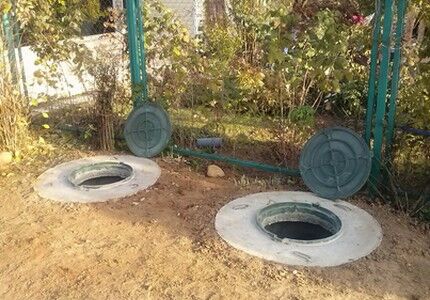
Among the main advantages septic tanks made of concrete rings worth highlighting:
- Affordable price. Due to the low cost of a septic tank made from rings, owners can afford to build such a structure even with limited financial resources.
- Strength and durability. In terms of strength characteristics, concrete is superior to brick and not inferior to natural stone. It is able to withstand strong pressure and is not afraid of large salvo discharges. And the service life of the structure can reach more than half a century.
- Tightness of tanks. The addition of properly installed waterproofing makes the structure of concrete rings resistant to groundwater from the outside and completely sealed from the inside.
To build a sewerage structure from rings, you will have to spend much less money than to purchase the same polypropylene container.
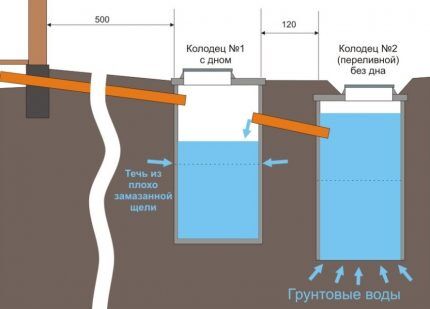
A septic tank made of concrete rings is not without its disadvantages.
These include:
- Heavy design. Therefore, to install such a multi-chamber structure, you will have to use special equipment or small-scale mechanization.
- The likelihood of wastewater penetrating into underlying soil layers. It occurs during the operation of the structure due to the appearance of cracks in the concrete, as well as the destruction of the sealing of the seams, which leads to the loss of its protective functions.
Before making a decision regarding the arrangement of a local sewage system using rings, analyze all the pros and cons of the material. And don’t forget to evaluate your capabilities regarding the use of construction equipment.
Construction options
The design of a septic tank made of concrete rings is not complicated. It can be a two- or three-chamber structure. Single-chamber drives operating on the principle cesspools, are used much less frequently.

Regardless of the type of design of the structure, when servicing it, it will be necessary to involve sewage equipment. It will remove solid waste that accumulates on the bottom and walls of storage tanks.
Single-chamber septic tanks are chosen when designing a sewer system for small-area country houses for seasonal residence, provided that the volume of wastewater is small. Good reasons for installing a single-chamber storage tank also include the high groundwater level and the predominance of clayey rocks in the geological section of the site.
Two- and three-chamber structures are installed when laying autonomous sewers for cottages intended for year-round living with large volumes of wastewater.
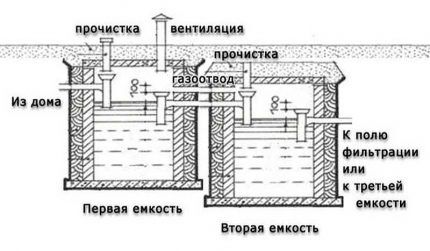
At arrangement of a two-chamber structure, supplemented by a filter well or filtration field, the first compartment is a sealed container with a limited supply of oxygen.
It is equipped with a cast iron or concrete hatch, as well as an inlet and outlet for drains. The second compartment is equipped with a ventilation pipe to create conditions for oxygen access.
When constructing a purifier that includes two or three reservoirs, the wastewater will be subjected to multi-stage purification by sedimentation and filtration:
- In the first drive – a primary purification process is carried out, in which large suspended matter is deposited and, under conditions of lack of oxygen, decomposes, and organic matter is processed by anaerobic bacteria.
- In the second chamber – the purification and filtration process continues, but with the participation of oxygen and aerobic bacteria. The decomposed remains of organic matter in the form of sludge settle to the bottom, and the clarified liquid enters the drainage, also known as absorption or filtering, well.
The water that has undergone further purification flows into drainage well, from where it goes into the ground through holes in the walls and passing through filtration through the sand-crushed stone layer.
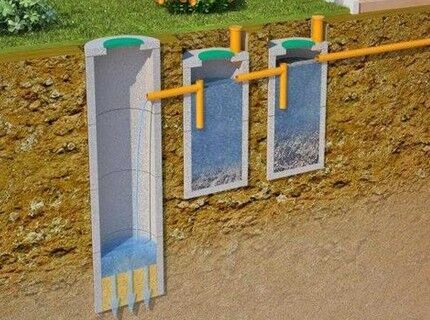
If the land plot is located on soils with good filtration properties that absorb and pass water well, and the groundwater level is not high, it is worth considering the option of installing a septic tank, in which the clarified liquid is discharged into an absorption well.
In areas with a groundwater level reaching only 2.5 m, the process of ground purification is most often impossible, since there must be at least a meter between the lowest point of the drainage well and groundwater. In this case, it is better to dispose of the wastewater treated by the septic tank to drainage fields.
The arrangement of such systems requires large square areas. But under given conditions, sometimes this is the only system that works.
Location of the structure
When designing a septic tank, the sanitary zone is placed in such a way that organic waste cannot penetrate into drinking water and fertile soil. To do this, when choosing a location, you should be guided by sanitary and building codes and regulations.
The correct location of the cleaning system on the site is regulated by:
- SNiP 2.04.03.85. It sets out the rules for the construction of external sewerage structures.
- SanPiN 2.2.1/2.1.1.1200-03. It lists the requirements for creating zones that are environmentally hazardous.
According to the standards, in order to avoid the foundation getting wet in the event of emergency leaks, the septic tank must be placed lower than the house is located.

When choosing a location, you should definitely take into account the presence of bodies of water with running water, maintaining a distance of 5 m to them. The distance from trees should be 3 m, from bushes - reduced to one meter.
It is also necessary to know where the underground gas pipe is laid. The distance to it should be at least 5 m.
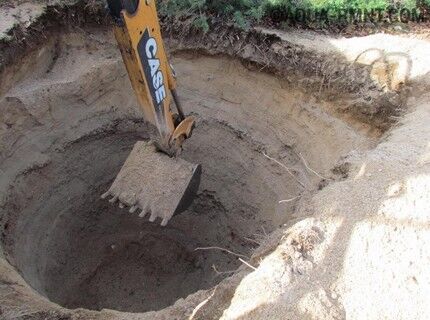
But keep in mind that the machine cannot be placed directly above the deepening site of the treatment plant. With their weight they can destroy the entire structure.
General installation rules
To create a strong and durable treatment structure, you should follow a number of basic rules:
- Distance between septic system wells should be at least half a meter. The gap filled with bitumen will act as a buffer when soil movements occur.
- The presence of crushed stone or gravel-sand cushion. Such a layer will ensure the immobility of the structure even if the soil under the tanks “goes wild”. In addition, it is necessary for draining water in case of leaking wells.
- Don't neglect waterproofing. To seal the seams between adjacent rings, it is recommended to use several types of insulating materials, treating both the inner surface and the outer walls of tanks.
The better the preparatory work is carried out and the more carefully all installation conditions are met, the less often you will have to call specialists to repair and clean the receiving tank.
Septic tank installation technology
There is nothing difficult in making a reliable and durable septic tank from rings. When designing several compartments, a linear construction principle is used, in which all concrete columns from rings are lined up along one line.
The receiving compartment and the following tanks are placed in close proximity to each other, and the filter column is located at a slight distance from them.
Step #1 - measurements and design
One of the prerequisites for effective wastewater treatment is to create conditions for it to remain inside the walls of the septic tank for at least three days. Therefore, the dimensions of the chambers are determined using the total three-day volume of wastewater as a basis.
According to standards, the daily volume of water consumption per household, subject to the use of household appliances, is about 200 liters.
So for a family of two or three people, the minimum volume of a treatment plant should be about two cubic meters. A family of 5-6 households will require a more spacious structure with a volume of 3-4 cubic meters.
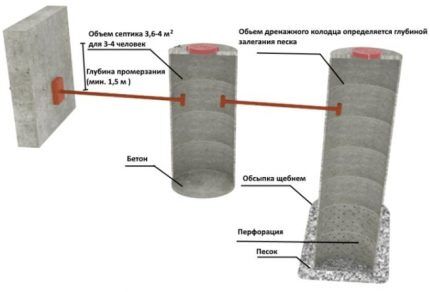
But when determining the volume of the structure, it is worth making a small reserve. After all, if guests arrive, there is a risk of “overfilling” the norm. And eliminating the consequences is a rather complex and at the same time expensive procedure.
The table below will help you determine what size rings you will need and in what quantity.
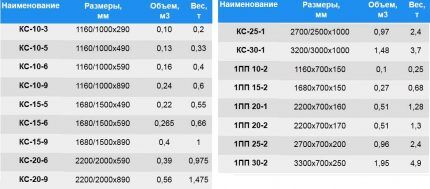
When choosing rings, keep in mind that the actual volume of the column must be clearly higher than the calculated one. This is due to the fact that as the drains fill, they rise only to the level of the overflow holes and never reach the top edge. Therefore, the calculated volume of liquid must be placed up to the level of these pipes.
Step #2 - preparing the necessary materials
At choosing rings for a septic tank It is advisable to buy products with locks. The presence of locks not only simplifies the installation process, but also prevents their displacement under the influence of frost heaving. When purchasing products, you need to pay attention to the evenness of the seats and carefully inspect the integrity of the locks.
In addition to the rings themselves, materials and construction tools will also be required:
- sewer pipes;
- fine crushed stone;
- river sand;
- polyurethane foam;
- cement mortar;
- waterproofing compounds;
- rolled thermal insulation materials;
- building level;
- ladder;
- perforator;
- wide brush;
- container for mixing the solution.
To create overflows between wells, you will need asbestos-cement or polypropylene pipes marked “for external sewerage».
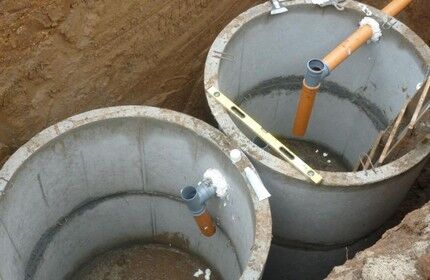
The diameter of asbestos-cement or polymer pipes used for overflow should be 110-120 mm.
Step #3 - digging a pit and arranging the bottom
It is better to carry out excavation work after the onset of the first frost or in the hottest months. During this period, the lowest groundwater level is observed.
The pit can be dug manually, by hiring a team of “diggers”, or by using the services of an excavator. If we take into account the costs of carrying out excavation work, then the costs of a team of diggers will be comparable to the amounts that will be spent on calling out special equipment.
The dimensions of the finished pit should exceed the dimensions of the installed rings by 50-80 cm. This will simplify the installation process and allow for external waterproofing of the joints of the structure.
When calculating the pit depth, three values are summed up: the height of the monolithic or filtration bed (20-30 cm) + the height of the rings (indicated in the table) + the height of the slab (15 cm).
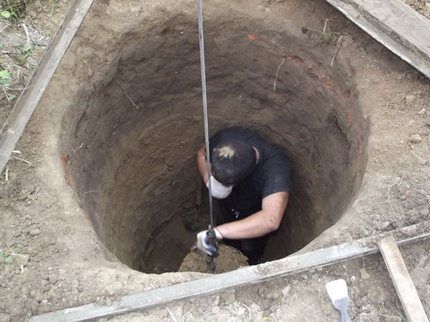
The pit for installing the treatment plant should be two-tiered: its second tank should be buried 50 cm lower than the first. Alternatively, dig your own hole for each tank.
To connect sewer pipes, trenches are dug, laying them below the freezing depth of the soil. The width and depth of the trenches are selected based on the dimensions of the rings used for the construction of the tanks. Most often they are made 50 cm wide with a depth of 1.2-1.5 m.
The bottom of the dug trenches should be downhill 2-3 cm, distributed per linear meter. It is better to calculate in advance the difference between the extreme points by multiplying the distance between them by the slope value stated by the standards.
Compliance with this condition will ensure gravity flow of the liquid. The leveled and compacted bottom of the trenches is covered with sand, forming a layer 10 cm thick.
The bottom of the pit is carefully compacted again.For concreting, standard cement mortar prepared in a 3:1 ratio is used.
If you plan to install a lower ring equipped with a bottom, you don’t have to construct a concrete screed. In this case, you can limit yourself to crushed stone filling, forming a layer 20 cm thick.
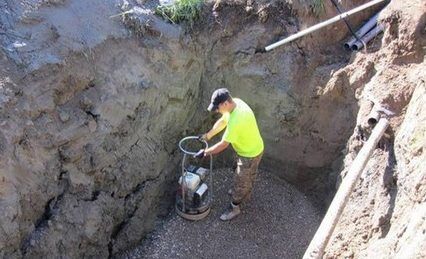
It is necessary to achieve an effect in which the pillow sags as much as possible. To thoroughly compact the embankment and achieve maximum density, tamping is alternated with filling the fill with water.
Step #4 - installing rings and sealing seams
The construction of a septic tank begins with the installation of its closed part - the lower ring, equipped with a bottom. It is set exactly so that the walls are positioned strictly vertically. Compliance with this condition will ensure the strength and stability of the structure.
When using a ring without a bottom as a base, the bottom of the pit must first be concreted. To do this, pour a concrete screed 30 cm thick. The dimensions of the created concrete screed should be 20 cm larger than the diameter of the immersed ring.
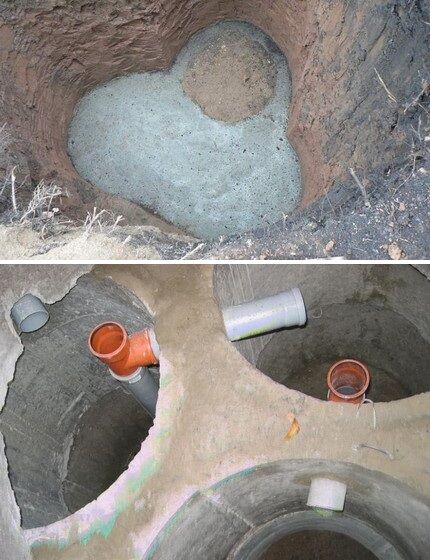
It can take up to two weeks for the concrete to harden. As soon as it acquires the necessary strength, install the first ring. Laying the rings without outside help is almost impossible. This work is performed with two or three assistants.
To protect the structure from leakage and reduce the harmful effects of groundwater on concrete, the joints between the base and the lower edge of the ring are thoroughly coated with waterproof cement mortar.
Ideal for waterproofing materials:
- bitumen mastic;
- deep penetration impregnation.
As an impregnation for treating concrete rings, it is good to use cement-based compositions such as “Penetron” or “Aquacement”.
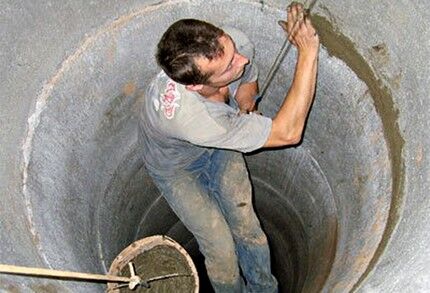
Toxic compounds must not be used for internal processing. During operation, they can destroy bacteria that are responsible for the decomposition of bio-inclusions.
All subsequent ones are installed on the first ring one by one. To create a more durable fixation, metal brackets are installed on the outside of the structure. The “entry” points of the staples are concreted and covered with a layer of insulation.
Immerse the rings into the tank using a tap. The resulting joints between the elements are also carefully sealed. The voids between the outer walls of the tank and the pit are filled with a mixture of soil removed when digging the pit and sand.
The “pockets” should be filled evenly, alternating compacting the soil composition with filling with water.
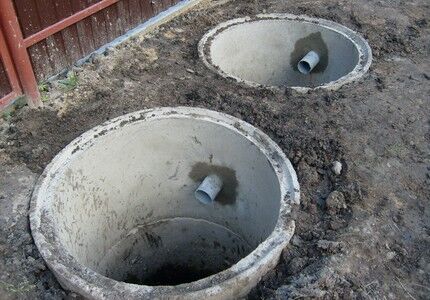
The upper part of the structure, located above the soil freezing level, should be insulated. In severe frosts, there is a high probability that an ice plug will form inside the tank. And this significantly reduces the speed and efficiency of cleaning.
It is convenient to use as a heat insulator:
- pieces of expanded polystyrene;
- finished shell products.
At the top of the columns, necks with holes for sewer hatches are installed. They are equipped with concrete or cast iron covers.
The second compartment of the purifier is equipped with a ventilation pipe. It should rise 70-80 cm above the ground surface.
Step #5 - installation of overflow pipes
The location of the overflow pipes is determined by the level of the pipe leading from the house. Since the overflow septic tank device is designed to ensure the movement of liquid by gravity, the highest point of the sewer pipe must be located below the freezing level of the soil.
The overflow on the opposite wall of the tank should be approximately 15-20 cm below the supply point.
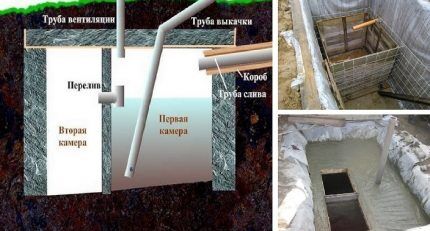
To connect the sewer pipe, a hole of the appropriate size is made in the wall of the ring using a perforator. The easiest way to fix the pipe in concrete is with polyurethane foam. It will retain moisture and act as a damper pad.
The entrance of the pipe to the tank wall is carefully sealed. The inlet pipes coming from the house, as well as the overflow pipes between the chambers, are equipped with tees.
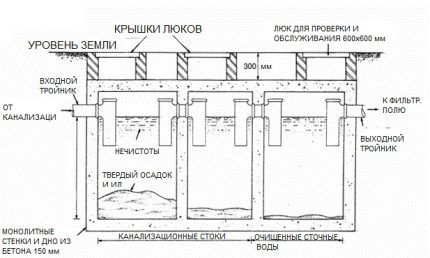
Tees at the ends of the outlet and inlet pipelines will provide unobstructed access for clearing blockages.
To increase the resistance of pipes to the most severe frosts, it is advisable to apply a layer of insulation to them and cover the top with a protective casing.
Creating a filtration well
A filter well can only be installed on a soil base that allows and absorbs water well. If sand, crushed stone or gravel-pebble deposits lie under its conditional bottom, then the disposal of treated wastewater into the underlying soil layers will occur without the slightest obstacle.
The 1 m absorption well is backfilled with a soil filter so that the backfill fractions decrease with height. First, the bottom is filled with sand - the thickness of the sand layer should be 30-40 cm, then a layer of fine gravel is formed - 30-40 cm.
The upper tier of the soil filter is usually larger crushed stone or gravel, which is covered with a layer of 20-30 cm.
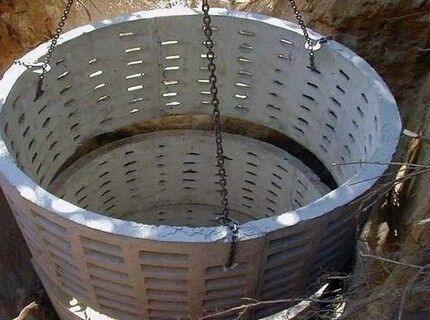
If wastewater is to be disposed of not only through the bottom, but also through the walls, the lower ring of the drainage well must be perforated. It is installed using the same technology as rings with solid walls. The voids between the walls of the pit and the concrete rings are filled with crushed stone.
If a filtration field is to be constructed, perforated pipes will be used. They are laid on a gravel-sand “cushion”, which ensures the infiltration of treated wastewater into the underlying soil layers, and the top is covered with geotextiles and covered with earth.
How to save on construction?
If it is not possible to use special equipment during installation and finances do not allow you to attract a team of workers, try using these methods.
Instead of traditionally digging a pit and then immersing rings in them, use a technology in which the soil is removed gradually as the ring is deepened. It is built on the fact that the ring falls down under the influence of its weight. The master’s task is to dig up the soil inside the ring and under its wall.

In this case, the concrete bottom will have to be poured later. And it will be located exclusively inside the ring.
A significant drawback of the described method is the inability to perform thermal and waterproofing on the outer walls of the structure. In addition, due to the fact that the bottom is located inside the ring, the reliability of the structure is reduced.
In an effort to reduce the cost of the structure itself, craftsmen offer an option for constructing a structure that looks like a triangle.
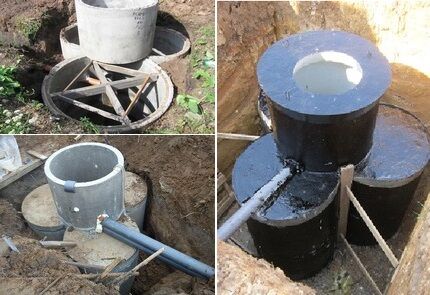
By choosing this arrangement option, you will save space for placing rings and can significantly reduce the amount of land work.
But during installation, take into account the peculiarity that the inspection entrance in such a design will be one per three rings.Therefore, all overflows should be placed outside its accessibility.
Conclusions and useful video on the topic
Option for arranging a two-chamber septic tank:
How to deepen rings without a tap:
In general, installing a septic tank from rings is not particularly difficult. You just need to strictly adhere to technology and follow safety rules. Thanks to this, the risk of wall collapse and displacement will be reduced to zero, and the structure will last for decades.
Do you have experience in arranging a septic tank from rings? Please share information with our readers or suggest your method of organizing an autonomous sewer system. You can leave comments in the form below.




Although it is said that you can do it yourself, there are so many nuances. The placement is regulated, it is necessary to take into account the conduct of communications, and the general installation requirements must be taken into account. For such work, you need to properly prepare, read, and, better yet, study together with specialists. But the idea is great considering the budget, but probably not for my site, which is constantly flooded.
Good day, Elena. In case of constant flooding, this sewerage option will not be suitable.
Pay attention to deep cleaning septic tanks. Up to 98% of treated wastewater is allowed to be discharged into a ditch. When choosing, pay attention to horizontal models. They are most suitable for installation in areas with high groundwater.
Proven inexpensive models include the Tver septic tank. A detailed review is available on our website here.
ICE.Where did you get the table with ring sizes from? According to the formula V=p*R*R*H, the volume of a KS 20-9 ring measuring 890 mm * 2000 mm = 3.14 * 1 * 1 * 0.89 = `2.79 cubic meters, and you have only 0.59 cubic meters
Yes, that’s right, volume is calculated using the formula V=p*R*R*H. And the table apparently takes the manufacturer’s data on the volume of concrete used to produce the ring.
Part of the comment was cut off. I hope I got there. I would be grateful if you could clarify this side too.